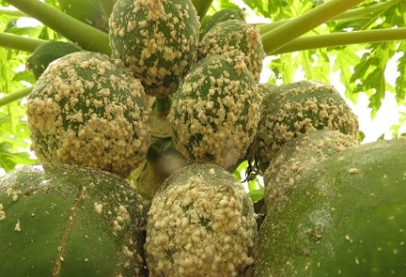|
The papaya mealybug Paracoccus
marginatus Williams and Granara de Willink (Hemiptera:
Pseudococcidae) is native to Mexico and/or Central America (Miller et
al. 1999) and was first described in 1992. This species was recorded
for the first time in Tamil Nadu, during July, 2008 in Coimbatore district (
which is considered to be invasive) on papaya and also on many ornamental
plants in the household and up to December,2008 it was restricted to
Coimbatore district and subsequently spread to neighbouring districts. Survey
was conducted immediately throughout the state of Tamil Nadu to study the
extent of damage and spread of the invasive mealybug, P.
marginatus. Severe infestation (80 to 90 %) was observed on the
crops viz., papaya, mulberry, tapioca, brinjal, tomato, bhendi and flower
crops.
Reasons
faster spread of Mealybug
A
white wax and flour-like substance around the body of the pest is the reason
for not able to control this pest easily. This pest spread rapidly due to lack
of natural enemies of these pests and it is a foreign originated insect. Also,
Reproduction of this mealybug is 15 times a year. It is also more capable of
laying. An insect lays between 500 and 600 eggs a year. The population is
growing at a higher level, thus causing great damage.
|
The papaya mealybug Paracoccus
marginatus Williams and Granara de Willink (Hemiptera:
Pseudococcidae) is native to Mexico and/or Central America (Miller et
al. 1999) and was first described in 1992. This species was recorded
for the first time in Tamil Nadu, during July, 2008 in Coimbatore district (
which is considered to be invasive) on papaya and also on many ornamental
plants in the household and up to December,2008 it was restricted to
Coimbatore district and subsequently spread to neighbouring districts. Survey
was conducted immediately throughout the state of Tamil Nadu to study the
extent of damage and spread of the invasive mealybug, P.
marginatus. Severe infestation (80 to 90 %) was observed on the
crops viz., papaya, mulberry, tapioca, brinjal, tomato, bhendi and flower
crops
.
Reasons faster spread
of Mealybug
A white wax and
flour-like substance around the body of the pest is the reason for not able
to control this pest easily. This pest spread rapidly due to lack of natural
enemies of these pests and it is a foreign originated insect. Also,
Reproduction of this mealybug is 15 times a year. It is also more capable of
laying. An insect lays between 500 and 600 eggs a year. The population is
growing at a higher level, thus causing great damage.
Symptoms
of Mealybug infestation
- White mealybugs present as a
patch like appearance in the base of the leaf stem, branches and stem.
- Presence of red and black
ants movement.
- Adhesive glossy honey- waste
like growth and dark fungal growth found on it and at high intensities,
plants showed like burnt withered leaves.
- Integrated Pest Management
system to be followed for controlling this pest.
- Keep the fields clean from
weed free.
- Uproot and destroy infested
plants and weeds to control spread of insects than pests.
Management
Release Acerophagus
papayae @ 100 parasitoids / field / village or block
|
|









Comments